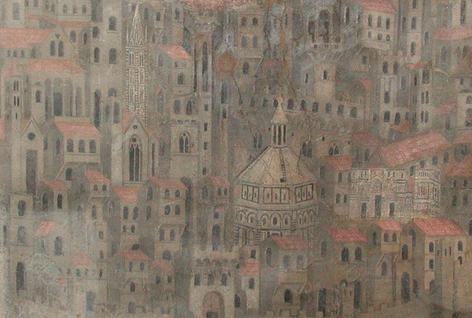Multi-Dimensional Civil War in Fourteenth-Century Florence October 15, 2014
Author: Beach Combing | in : Medieval , trackbackCivil Wars are generally – the American Civil War is a fascinating exception – confusing with there almost inevitably being more than two factions. However, it is arguable whether, with apologies to Syria and Bosnia, the world has ever experienced civil wars quite as confusing as those reported in Florence, Italy in the fourteenth century. Florence was by 1300 an immensely rich but divided metropolis, one of the richest cities in the world. Wealthy families – and money counted for far more than blood in Republican Florence – had towers within the city walls that acted as independent castles (see the contemporary image above). By 1300 there were as many as 200 of these city castles, and certainly 150. The greatest danger to Florentine freedom came not from Rome or Milan or the Emperor across the Alps but from the battles between the families who united and divided with each other as they saw gaps open in their opponents’ armour. Along with the families there were other factions. The Church (of course), the loose wickerwork authority of the podestà (the head of Florence’s government), the arte (or guilds) and militias formed from the lower classes, always looking to enforce class privileges against the interests of their greedy masters.
Eventually this mess of rivalling interests would be calmed by the overriding power and ruthlessness of the Medici, the towers would be pulled down and the Republic would begin to assert something approaching the rule of law. But in the early 1300s it was a dog eat dog world, a world where dozens of different mean-fanged fidos ran around looking to cause trouble. In these years the city veered from one civil war to another. As soon as conflicts broke out then partisans would run to their towers and lift up heavy anti cavalry chains to protect ‘their’ streets, with the popolo magro (the lower middle classes) and the commoners running for cover and a good vantage point to see their betters maiming each other. Many of the major families changed sides so often that it must have been a real effort for those carrying the family’s swords to recall who they were supposed to give a dust bath and who they were supposed to loyally support.
An example. By 1303 the city had divided into two factions the White and the Blacks, ostensibly over relations with the Pope but really to better settle accounts with enemies. The Blacks and Whites spilled a great deal of blood, but they at least provided a stable ecology for the city as they were evenly balanced. In that fateful year though Corso Donati, a Black leader, broke away to form a third faction with some disillusioned Whites. A three-way fight was, though, just too simple for Florence so other ingredients were stirred in. City government tried to restore order battling the three factions into a corner, then having failed Florence’s Republic invited soldiers from nearby Lucca to come and make peace over the government’s head. This inspired a new faction of Florentines who had no particularly ideological stance save their detestation of the Luccan peacekeepers. By the end of the year, Blacks, Whites, Donatists, Luccans, Republicans and anti-Luccans were all scrapping and trying to remember why they were spilling blood. Much of the violence was cosmetic: a herald from Lucca had, on his first visit to the city, a sword stuck in his face. But other acts of violence were more devastating. The Bishop of Florence who was allied to Corso Donati actually put a catapult on the top of his palace and began to shoot this heavy siege artillery at nearby towers! Perhaps the only example of siege warfare within a city in western history. An army approaching from Milan intent on sacking rich Florence might have arrived at the gate and then turned tail and run at the sheer confusion and horror of the violence within. No one messed with the Florentines save the Florentines themselves but they did it on a semi-permanent basis.
Other confusing civil wars: drbeachcombing AT yahoo DOT com



